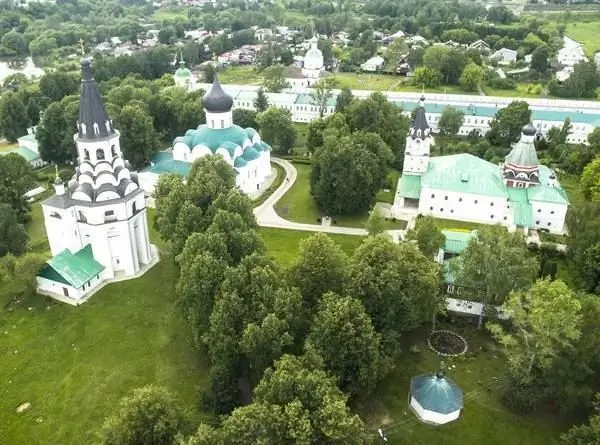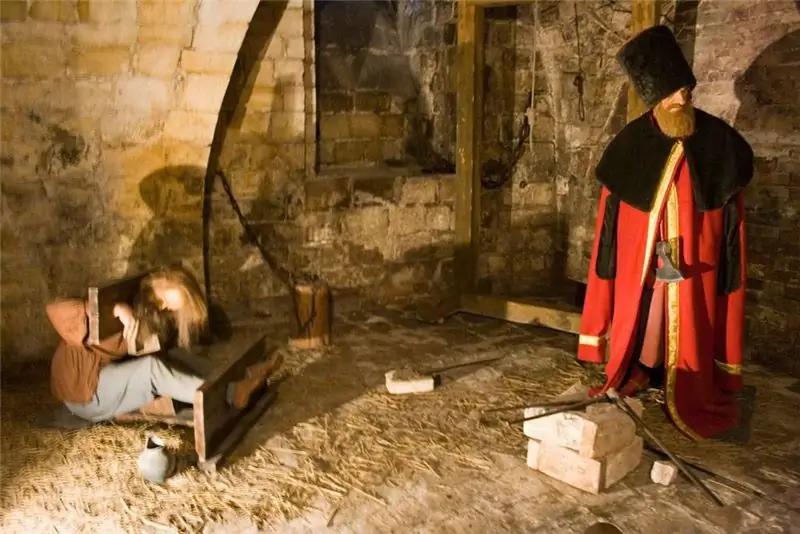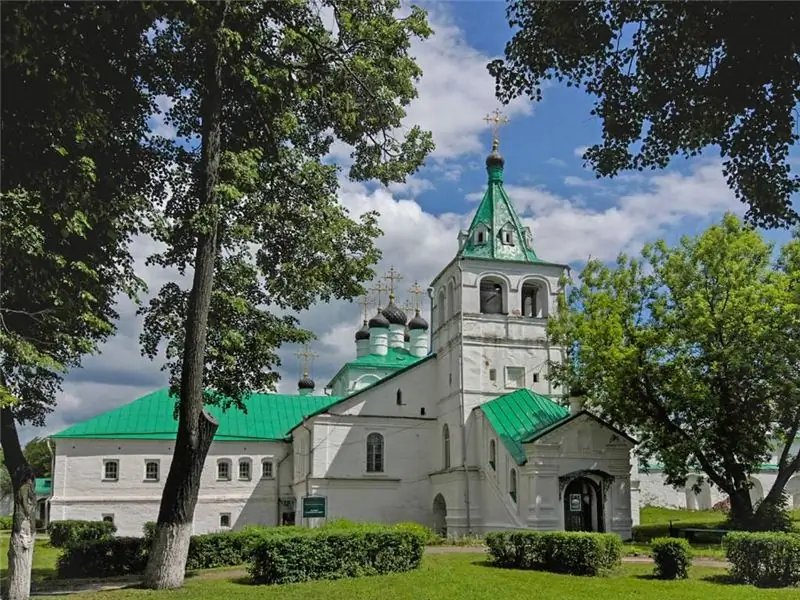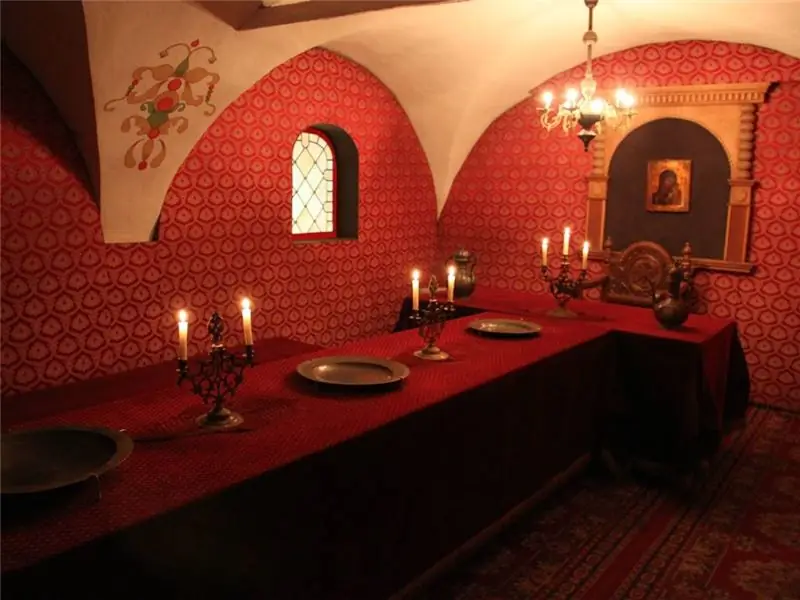
Description of the attraction
Aleksandrovskaya Sloboda - old patrimony of the Romanov family … Under Ivan the Terrible, it was the actual capital of the state, then the sister of Peter I, Princess Martha, lived here in prison, later the crown princess Elizabeth Petrovna often visited. Now there is a museum with several exhibitions located in historical buildings, and a functioning Assumption Convent.
The history of the settlement
Aleksandrovskaya Sloboda is known to us from early 15th century … It was a small village that fell in love with the great Moscow to Prince Vasily III, and he set up his country residence here. In 1513, a palace and a stone Pokrovsky Cathedral were built for him.
But this place is much better known as the oprichnina residence of the next king - Ivan the Terrible.
Historians and politicians are still arguing about how to assess the figure of Ivan the Terrible - as a progressive ruler who strengthened the Moscow state, or as a tyrant and maniac who unleashed real terror in his country. One way or another, the history of the Aleksandrovskaya Sloboda is inextricably linked with his memory.
Officially, Ivan the Terrible came into law in 1545 with his majority, and in 1547 he was married to the kingdom. He began his reign with progressive reforms: he adopted a new Code of Laws, convened the Zemsky Sobor - the Russian version of parliament, streamlined the system of state orders, that is, different branches of government. Under him, Kazan and Astrakhan became part of the state … However, at some point, the tsar concentrates on searching for internal enemies.
In 1565, he divides his country in fact into two unequal parts: oprichnina - that is, their personal lands, and Zemshchina - that is, everything else. Repressions are unfolding against the Zemshchina. Protesters against the oprichnina and even just beating their brows with requests to abolish such a division are brutally executed. In 1570, the tsar went on a campaign against Novgorod, suspecting him of treason - and in the annals this campaign remained as the most cruel of his deeds. The tsar exterminated ordinary Novgorodians by the thousands.

The new de facto capital of the state became oprichnaya Aleksandrovskaya Sloboda … Grozny moved here, officially abdicating the throne, taking his famous library and state treasury. The oprichnina was established by the tsar as a monastic order, in which he himself acted as hegumen. The oprichniks had a special robe, similar to a monk's, but with weapons, and their own signs: a dog's head, symbolizing loyalty to the king and readiness to tear apart his enemies, and a broom with which they swept "litter" out of the country. In the very Aleksandrovskaya Sloboda, the tsar really performed hegumen's duties: he woke everyone up with bell ringing for matins, sang in the kliros.
However, soon, after much persuasion, he nevertheless returned to Moscow for the official assumption of power again - and demanded 100 thousand rubles from the Zemsky Prikaz for his forced movements. But the Aleksandrovskaya Sloboda remained his capital - in the future he traveled to Moscow only when necessary. It was here that he received foreign ambassadors and negotiated, it was in these basements that he tortured boyars suspected of treason. Grozny continued to live here until 1581, until the year of his son's death - Tsarevich Ivan … We do not know whether it was true that the father killed his son, but the tragedy took place right here, in the Aleksandrovskaya Sloboda. Legend says that Ivan the Terrible beat the prince to death with an iron staff, suspecting him of a conspiracy and a desire to seize power. According to other sources, at first the tsar began to beat his pregnant wife, the tsarevich stood up, and then the distraught father began to beat him. One way or another, Grozny left the Aleksandrovskaya Sloboda after that and never returned here.
In 1885, a famous painting was painted on this subject Ilya Repin "Ivan the Terrible kills his son." A copy of this painting is one of the main exhibits of the current museum exhibition.
Under Ivan the Terrible, the wooden walls of the fortress are replaced with brick ones, they are updated Pokrovsky and Trinity churches, appears high Bell towerare under construction Royal chambers.
After the departure of Ivan the Terrible, life in the settlement did not stop. Since the 16th century, there is the Assumption Monastery, for which the tsar donates a lot Fedor Alekseevich … Under him, over the western gate was built church in the name of Fyodor Stratilat, his patron saint. The village itself remained the fiefdom of the Romanov family, and the reigning persons regularly came here. For example, in these places the crown princess was very fond of hunting Elizaveta Petrovna, the future empress - Aleksandrovskaya Sloboda since 1727 belonged to her.
After the revolution, the territory of the monastery and all its buildings were transferred the museum … At the moment, the monastery has been revived, and is adjacent to museum expositions.
What to see

Trinity Cathedral - a classic Vladimir-Suzdal five-domed temple. It dates back to 1513 and was almost never rebuilt, only renovated and repaired. The cathedral is decorated with two trophies of Ivan the Terrible: the gate brought from Novgorod Sofia after the devastation of Novgorod, and the gate from the Tver Cathedral of the Transfiguration. The temple was painted in the 19th century by Palekh masters, but several fragments of the 16th century murals have survived. The temple is currently active. One of its main shrines is relics of St. Cornelius Alexandrovsky … This was a monk who lived in the 17th century. He became famous for his holy life, founded several monasteries near Alexandrov and was the confessor and mentor of the Assumption Convent. Cornelius was canonized in 1984.
Crucifixion church-bell tower and Martins chambers - originally this building was not a temple, but a high watchtower. Under Ivan the Terrible, it was converted into a bell tower, inside which a small Church of the Crucifixion and several service premises were arranged. The bell tower is 56 meters high. In the premises next to the church, according to some historians, the royal interrogation and torture rooms were located.
Already in the 17th century, another small building with four rooms was added to the bell tower. It was here that she lived as a nun, tonsured by Peter I Princess Martha Alekseevna … During a conflict with young Peter, her older sister Sophia sent her along with other relatives to Peter for reconciliation. Reconciliation did not happen, and all the participants paid the price. Martha was tonsured a nun and settled in the Assumption Monastery.
The bell tower is now arranged observation deck, and in the Martha Chambers there are expositions telling about Princess Martha (tiled stoves of the 17th century, furniture and icons have been preserved here), the history of the Assumption monastery, and about the mysteries of history associated with the Alexander Sloboda: the secret of the library of Ivan the Terrible, the first man's attempt to create an aircraft etc.

The main exposition of the museum is located in Of the royal chambers and adjoining tent Church of the Intercession … The church dates back to the 1510s and is one of the first Russian tent-roofed churches. Preserved unique painting of the tent on the Old Testament subjects. They were opened in 1925 during the restoration.
Ivan the Terrible once lived in these chambers, and the church was his home church. The exposition is dedicated to this particular period in the life of the Aleksandrovskaya Sloboda. Various images of Ivan the Terrible are presented - in painting, graphics, sculpture and even cinema. One of the rooms reproduces the interior of the dining room, with crockery and tableware of the 17th century, the other is dedicated to the king's family life and his weddings. Three-meter cellars have been preserved under the chambers. In one of their rooms there is now an exposition dedicated to the history of the fortress itself, in the other there is a torture chamber with Malyuta Skuratov, and in the third there is an exhibition representing the art of the 17th-18th centuries: icon painting, household items, etc.
V Assumption Church XVI centuries. located exhibition hall of contemporary Orthodox art, as well as an exposition dedicated to the Alexander merchants of the XIX-XX centuries. Once it was the home church of the princesses of the Romanov dynasty, so it is distinguished by its comfort and elegance. In the 18th century, a tent-roofed bell tower appeared near the church, and a clock of the latest design was installed on it.
V Cell building, which is adjacent to the church, is now a creative center, where you can take part in master classes on making tiles and Slavic amulet dolls, and in a nearby wooden cell there is an exhibition dedicated to the life of a Russian village.
V Hospital building there is an exhibition of things from the noble estates of the Aleksandrovsky district - primarily from the estate of the Buturlins-Zubovs. The original interiors of the provincial estates of the 19th century have been recreated. A small Sretenskaya Church of the 18th century adjoins the Hospital building - once it was the tomb of Princess Martha.
Interesting Facts
- In the Aleksandrovskaya Sloboda, they are convinced that the library of Ivan the Terrible is hidden somewhere in the local basements.
- They say that once there was such a wide underground passage leading out of the fortress from the Assumption Church that a carriage pulled by three horses could pass there. The move was called the "king's pipe".
On a note
- Location. Vladimir region, Alexandrov, Museum pr., 20.
- How to get there: by train from Yaroslavsky railway station to Aleksandrov station, then by buses No. 7, 4 to the Aleksandrovsky Kremlin stop.
- The official website of the museum:
- The official website of the Assumption Monastery:
- Working hours: 10: 00-18: 00, Monday - day off.
- Ticket prices. One ticket for all expositions. Adult 380 rubles, concessionary - 350 rubles.
- The museum is equipped to receive visitors with disabilities.






